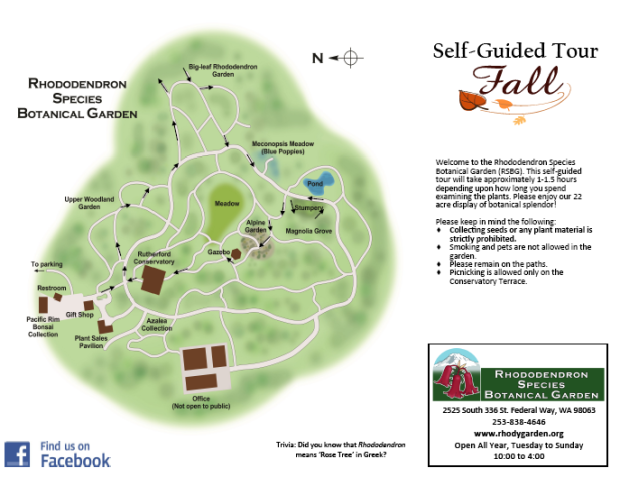Download the Fall_2014 Self-Tour
Please follow the black numbered signsfor this self-guided tour. From the Garden Shop, walk straight to visit #1 Viburnum plicatum var. tomentosum (Doublefile Viburnum*) native to China and Japan. This deciduous shrub provides beautiful white blossoms in the spring as well as stunning reddish-bronze fall foliage color. Right behind is #2 Acer palmatum ‘Shishigashira’ meaning ‘lion’s head’ in Japanese. This tree is one of the last Japanese maples to “color-up” in the autumn, changing to bright orange in mid November.
Take a left on the main road and follow the sign to visit the Upper Woodland Garden which features many rhododendrons with thickly indumented leaf undersurfaces. A little further on, you will see #3 Acer sieboldianum on your right. The brilliant scarlet autumn coloration is an outstanding feature of this species. This is one of the most common species in the mountain forests of Japan. Keep going until you see #4 Speirantha convallarioides, False Lily of the Valley, on your left. This is a choice, very slow-growing evergreen groundcover with fragrant flowers in spring. Nearbyis #5 Coptis laciniata*, Gold Thread. This slow-spreading groundcover is native to the Pacific Northwest. The name comes from the golden yellow rhizomes that creep just beneath the surface of the ground.
Follow the sign to the main path and make a left turn. Pass the bamboo on your right and follow the sign to the narrow path on your left. This area is called the Big Leaf Garden. Most of the big-leaf rhododendrons eventually become very large trees in their native temperate rainforests in the Sino-Himalayas. Continue straight ahead and stay on the path to visit #6 Acer palmatum ‘Emerald Lace’ on your right. This is an outstanding small specimen tree with delicately dissected leaves. The leaves emerge a brilliant green with red petioles in spring.
Follow the sign to visit the newly renovated Big-leaf forest. Here you will find particularly hardy big-leaf species for our Pacific Northwest climate such as R. kesangiae* and R. hodgsonii*. In 10 years, most of the rhododendrons planted in this area will be 15 to 20 feet tall.
Take the path to the left to the display of #7 Rhododendron rex* on both sides. This plant has extremely attractive, shiny deep-green foliage with a thick gray to buff indumentum beneath. In China, where it is native, it can attain heights of up to 45 feet. R. rex is one of the hardiest big-leafed rhododendrons in our climate. On your left, you will see #8 Rehderodendron macrocarpum (meaning big-fruited Sir Rehder’s tree). The fruits of this tree are about 2 inches long and hard as a rock.
Now, make a left turn on the main path. Keep going until you see the Himalayan Blue Poppy Meadow on your left. The towering stalks hold the seed pods of #9 Cardiocrinum giganteum, the Himalayan Giant Lily from the Sino-Himalaya. These fragrant lilies bloomed in June with the tallest one measuring a whopping 13’9” tall! They are monocarpic which means they die after producing flowers. The clumps of fuzzy leaves are the blue poppies which bloom in the spring.
Keep going along the main path until you see #10 Acer griseum,Paperbark Maple, on the left corner. This Chinese native features scarlet fall foliage as well as the decorative exfoliating bark. Keep walking to the display of #11 Rhododendon exasperatum. The foliage of this rare species emerges blue-green and stays smooth and glossy throughout the season. Under R. exasperatum, you will find #12 Gaultheria nummularioides from China. This small scale, evergreen groundcover spreads by aboveground and underground runners. This plant performs well under the rhododendrons forming a dense and attractive mat.
Walk the main path and you will see the Hardy Fern Foundation’s Victorian Stumpery (#13) on your right. A Stumpery is an English Victorian period garden design that romanticizes nature. The design uses tree roots and stumps placed on their sides or upside down creating a “Wild Scene” which is then planted with thousands of ferns and other woodland plants. Have a seat on the cut cedar-log bench at the top of the Stumpery and enjoy the view of the pond garden. Exit the Stumpery from the opposite end, and enjoy the fall color of #14 Oxydendron arboreum*, Sourwood. It is native to the Appalachian Mountains and belongs to same family as rhododendrons. It has fragrant white flowers in summer.
Walk back along the main path towards the paperbark maple and take the first left path. Go up the hill and you will find #15 Rhododendron pachysanthumon your left. This is one of the finest foliage plants in the genus Rhododendron. Indumentum color ranges from silver-white to rich brown on the upper surface. It’s native to Taiwan. Up the hill is the Alpine Garden (#16). Before you explore the alpine garden, let’s visit the #17Katsura Tree (Cercidiphyllum japonicum) from Japan. You might notice the cotton candy scent that’s given off by its fallen leaves. Some people describe the scent as caramel or cinnamon.
Now, walk back to the alpine garden and walk up the hill. Most of the plants here are found at high altitudes in the mountains of Asia. Visit #18 Polygonum vacciniifolium from the Himalayas on your left. This plant performs well as a groundcover under large rhodies as well as in rock gardens. The foliage turns bright red in the fall.
Walk up towards the Gazebo which is surrounded by #19 Rhododendron degronianum ssp. yakushimanum. This species is only found on the very top of an ancient volcano on Yaku-island, Japan. The foliage of this plant has thick fulvous indumentum. Follow the sign for the self-guided tour which will take you past #20 Stewartia pseudocamellia, Japanese Stewartia, on your left. This is a summer flowering tree with beautiful bark. This camellia relative also has a colorful fall foliage. Continue straight ahead for the Rutherford Conservatory (a separate self-guided handout to tour the Rutherford Conservatory is available inside).
From the front door of the conservatory, head back to the main path and take a left. The last stop of this tour is #21 Fothergilla major on your left. This plant belongs to the witch-hazel family and is native to the southeastern USA. The foliage of this plant turns cherry-red, orange or bright yellow in the fall and is very attractive. From here, you can walk back to the garden shop where you started. We hope you enjoyed the self-guided tour today. Please come back and visit the garden again soon.

